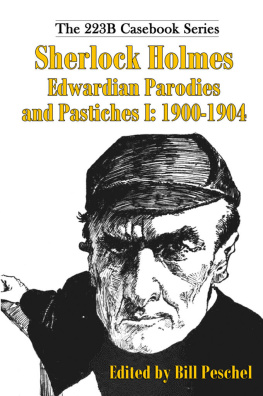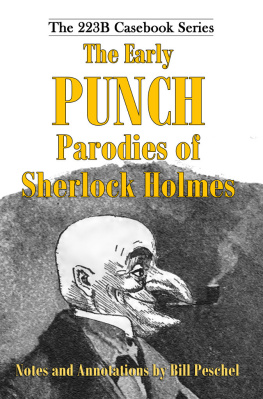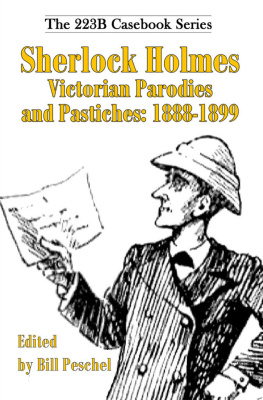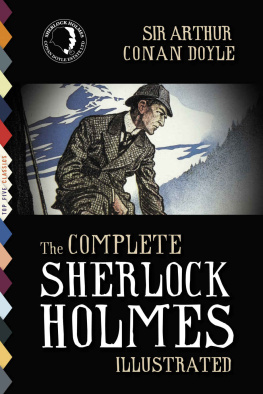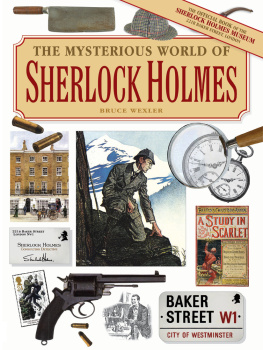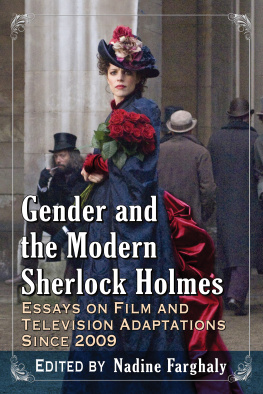Welcome to 223B Baker Street
The debut of Sherlock Holmes in the pages of The Strand magazine introduced one of fictions most memorable heroes. Arthur Conan Doyles spellbinding tales of mystery and detection, along with Holmes deep friendship with Doctor Watson, touched the hearts of fans worldwide, and inspired imitations, parodies, songs, art, even erotica, that continues to this very day.
Sherlock Holmes Edwardian Parodies and Pastiches I: 1900-1904 collects more than 55 piecesshort stories, poems, newspaper clippings, and cartoonsall published during the opening years of Conan Doyles literary career. Also included are much of the original art and more than 200 footnotes identifying obscure words, historical figures, and events that readers were familiar with at the time.
Peschel Press 223B Casebook seriesnamed because theyre next door to the original storiesis dedicated to publishing the fanfiction created by amateur and professional writers during Conan Doyles lifetime. Each book covers an era, publication, or writer, and includes lively mini-essays containing insights into the work, Conan Doyle, and those who were inspired by him.
A lifelong fan of mysteries, and Sherlock Holmes in particular, Bill Peschel is a former award-winning journalist living in Hershey. He is the annotator of novels by Agatha Christie and Dorothy L. Sayers, publisher of the three-volume Rugeley Poisoner series, and author of Writers Gone Wild (Penguin).



Edited by Bill Peschel

Peschel Press ~ Hershey, Pa.
Introduction
Welcome back to another volume in the 223B Casebook series! This one covers the period 1900 to 1904, a time of great change in Arthur Conan Doyles life. He moved into the public sphere by running for parliament, and revived Holmes twice, the first time temporarily with The Hound of the Baskervilles, and then permanently with The Adventure of the Empty House.
By this time, it became clear that Holmes was going to endure. Although he had gone over Reichenbach Falls at the end of 1893, the flood of appearances in stories, cartoons, and ads did not abate. If anything, it ballooned, which is why this and future volumes will cover five years, after the 12-year span in the first. In fact, an argument could be made that these parodies and pastiches played a major role in keeping Holmes alive. Each new appearance reminded the public that Sherlock existed, and no matter how entertaining they were, there was only one true Holmes, and one man who could write him.
As the original Holmes spread deeper into the world, his parody doppelgangers underwent changes as well. This was partly due to the times. Queen Victoria died in 1901 and Britain mourned her passing and looked forwardnot without some trepidationto the Edwardian Age. When Britain marched into the Boer republics under the banner of imperialistic expansion, Holmes and Watson marched along with them (The Adventure of the Pink Pearl). Peoples rising interest in the automobileConan Doyle among themis reflected in The Affair of the Lost Compression. The dubious question of who wrote Shakespeares plays was given the stink-eye by John Kendrick Bangs and Charlton Andrews. Even Americas presidential election of 1904 became fodder for humor in The Adventure of the Campaign Issue and The Lost Democratic Majority.
Then there is Holmes as a pre-postmodern meta commentator, squabbling with his creator over money (The Adventure of the Second Swag), defending Conan Doyle from Brigadier Gerards accusation of plagiarism, and mocking the plots of best-selling books (The Book of 1900). Several stories even combined characters from different authors, anticipating Alan Moores The League of Extraordinary Gentlemen by a century.
For the first time, Holmes acts as a social critic, commenting on the trusts abuse of power in Sherlock Holmes Analyzes a Perfect Stranger. In future books, hell be portrayed as a villain, representing forces that oppress workers. Holmes as a capitalist tool, if you will.
Reading these stories in chronological order, we also can see how Arthur Conan Doyles life and works inspired responses from the literati. His resurrection of Holmes in The Hound of the Baskervilles and The Adventure of the Empty House led to The Cat of the Bunkervilles and The Bound of the Asterbilts. Even personal events in his life was fodder; his foray into parliamentary politics was commented on in How Holmes Tried Politics as well as a recently discovered parody.
There was also room in this volume for humor, both low and high. Alongside the silly stories, such as the case of the stolen doormat and how a mans coat reveals details of his domestic life, are contributions from pros such as Mark Twain, Bret Harte, and Finley Peter Dunne. Even more interesting are the amateurs who drew from their life experiences. Theres the doctor who treated Watson as the no-nonsense medical man he would be in real life, someone who wouldnt have put up with Holmes condescension for an instant. A couple of New England schoolboys tried their hand at a pastiche, both of whom coincidentally grew up to become Paris-trained architects. A future U.S. federal court judge brought Holmes and Watson to the University of Virginia, giving us a glimpse of collegiate life at a time when it was out of reach of many.
Digging up these stories was fun, especially with the help of those who are thanked in the acknowledgements. But so was learning everything I could about the stories behind the stories. I hope youll enjoy them, too.
Bill Peschel
Hershey, Pa.
April 29, 2015
How the Book Was Organized
The 223B Casebook Series had two goals: To reprint the majority of the parodies and pastiches published in Conan Doyles lifetime, especially rare items not readily available, and stories under a single subject, such The Early Punch Parodies of Sherlock Holmes, or around an author such as John Kendrick Bangs. Examples of material published in the single-subject books will appear in the chronologically-based books, but not all of them.
The stories in the chronological books appear in the order in which readers of the time would have seen them. This way, readers can see how writers changed their perception of Sherlock as the canonical stories were published. Stories for which dates could not be found, such as those published in books, were moved to the back of the year.
Each chapter begins with a description of Conan Doyles activities that year. I tried to keep the essays self-contained, but some events, such as Conan Doyles longtime relationship with Jean Leckie, span years, and you may have to read the essay in earlier books in the series to fully understand them.
The stories were reprinted as accurately as possible. No attempt was made to standardize British and American spelling. Some words have undergone changes over the yearsShakespere instead of Shakespeare and to-morrow for tomorrowthey were left alone. Obvious mistakes of spelling and grammar were silently corrected and paragraphs were broken up to aid readability.

